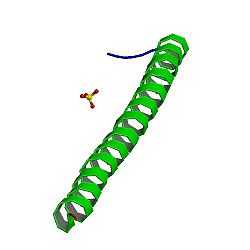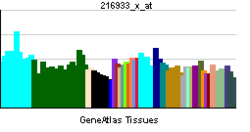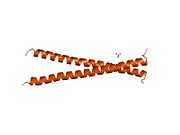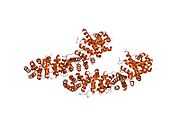Adenomatous polyposis coli
This article refers to the tumor suppressor APC, in which mutations lead to colon cancer. For the cell-cycle regulatory complex, APC/C, see Anaphase-promoting complex.
Adenomatous polyposis coli (APC) also known as deleted in polyposis 2.5 (DP2.5) is a protein that in humans is encoded by the APC gene.[1] The APC protein is a negative regulator that controls Beta-catenin concentrations and interacts with E-cadherin, which are involved in cell adhesion. Mutations in the APC gene may result in colorectal cancer.[2]
APC is classified as a tumor suppressor gene. Tumor suppressor genes prevent the uncontrolled growth of cells that may result in cancerous tumors. The protein made by the APC gene plays a critical role in several cellular processes that determine whether a cell may develop into a tumor. The APC protein helps control how often a cell divides, how it attaches to other cells within a tissue, or whether a cell moves within or away from a tissue. This protein also helps ensure that the chromosome number in cells produced through cell division is correct. The APC protein accomplishes these tasks mainly through association with other proteins, especially those that are involved in cell attachment and signaling. The activity of one protein in particular, beta-catenin, is controlled by the APC protein (see: Wnt signaling pathway). Regulation of beta-catenin prevents genes that stimulate cell division from being turned on too often and prevents cell overgrowth.
The human APC gene is located on the long (q) arm of chromosome 5 in band q22.2 The APC gene has been shown to contain an internal ribosome entry site. APC orthologs[3] have also been identified in all mammals for which complete genome data are available.
Structure
The full-length human protein comprises 2843 amino acids with a (predicted) molecular mass of 311646 Da. Several N-terminal domains have been structurally elucidated in unique atomistic high-resolution complex structures. Most of the protein is predicted to be intrinsically disordered. It is not known if this large predicted unstructured region from amino acid 800 to 2843 persists in vivo or would form stabilised complexes - possibly with yet unidentified interacting proteins.[4] Recently, it has been experimentally confirmed that the mutation cluster region around the center of APC is intrinsically disordered in vitro.[5]
Role in cancer
The most common mutation in colon cancer is inactivation of APC. When APC does not have an inactivating mutation, frequently there are activating mutations in beta catenin. Mutations in APC can be inherited, or arise sporadically in the somatic cells, often as the result of mutations in other genes that result in the inability to repair mutations in the DNA. In order for cancer to develop, both alleles (copies of the APC gene) must be mutated. Mutations in APC or β-catenin must be followed by other mutations to become cancerous; however, in carriers of an APC inactivating mutations, the risk of colorectal cancer by age 40 is almost 100%.[2]
Familial adenomatous polyposis (FAP) is caused by an inherited, inactivating mutation in the APC gene. More than 800 mutations in the APC gene have been identified in families with classic and attenuated types of familial adenomatous polyposis. Most of these mutations cause the production of an APC protein that is abnormally short and presumably nonfunctional. This short protein cannot suppress the cellular overgrowth that leads to the formation of polyps, which can become cancerous. The most common mutation in familial adenomatous polyposis is a deletion of five bases in the APC gene. This mutation changes the sequence of amino acids in the resulting APC protein beginning at position 1309.
Another mutation is carried by approximately 6 percent of people of Ashkenazi (eastern and central European) Jewish heritage. This mutation results in the substitution of the amino acid lysine for isoleucine at position 1307 in the APC protein (also written as I1307K or Ile1307Lys). This change was initially thought to be harmless, but has recently been shown to be associated with a 10 to 20 percent increased risk of colon cancer.
Regulation of proliferation
The (Adenomatous Polyposis Coli) APC protein normally builds a "destruction complex" with glycogen synthase kinase 3-beta( GSK-3β) and axin via interactions with the 20 AA and SAMP repeats. This complex is then able to bind β- catenins in the cytoplasm, that have dissociated from adherens contacts between cells. With the help of casein kinase 1 (CK1), which carries out an initial phosphorylation of β-catenin, GSK-3β is able to phosphorylate β-catenin a second time. This targets β-catenin for ubiquitination and degradation by cellular proteasomes. This prevents it from translocating into the nucleus, where it acts as a transcription factor for proliferation genes. APC is also thought to be targeted to microtubules via the PDZ binding domain, stabilizing them. The deactivation of the APC protein can take place after certain chain reactions in the cytoplasm are started, e.g. through the Wnt signals that destroy the conformation of the complex. In the nucleus it complexes with legless/BCL9, TCF, and Pygo.
The ability of APC to bind β-catenin has been classically considered to be an integral part of the protein's mechanistic function in the destruction complex, along with binding to Axin through the SAMP repeats.[6] These models have been substantiated by observations that common APC loss of function mutations in the mutation cluster region often remove several β-catenin binding sites and SAMP repeats. However, recent evidence from Yamulla and colleagues have directly tested those models and imply that APC's core mechanistic functions may not require direct binding to β-catenin, but necessitate interactions with Axin.[7] The researchers hypothesized that APC's many β-catenin binding site increase the protein's efficiency at destroying β-catenin, yet are not absolutely necessary for the protein's mechanistic function. Further research is clearly necessary to elucidate the precise mechanistic function of APC in the destruction complex.
Mutations
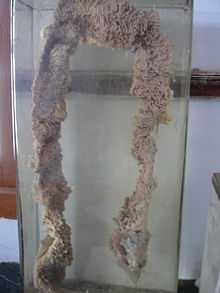
Mutations in APC often occur early on in cancers such as colon cancer. Patients with familial adenomatous polyposis (FAP) have germline mutations, with 95% being nonsense/frameshift mutations leading to premature stop codons. 33% of mutations occur between amino acids 1061-1309. In somatic mutations, over 60% occur within a mutation cluster region (1286-1513), causing loss of axin binding sites in all but 1 of the 20AA repeats. Mutations in APC lead to loss of β-catenin regulation, altered cell migration and chromosome instability.
Neurological role
Rosenberg et al. found that APC directs cholinergic synapse assembly between neurons, a finding with implications for autonomic neuropathies, for Alzheimer's disease, for age-related hearing loss, and for some forms of epilepsy and schizophrenia.
Interactions
APC (gene) has been shown to interact with:

See also
References
- ↑ Nishisho I, Nakamura Y, Miyoshi Y, Miki Y, Ando H, Horii A et al. (August 1991). "Mutations of chromosome 5q21 genes in FAP and colorectal cancer patients". Science 253 (5020): 665–9. doi:10.1126/science.1651563. PMID 1651563.
- ↑ 2.0 2.1 Markowitz SD, Bertagnolli MM (December 2009). "Molecular origins of cancer: Molecular basis of colorectal cancer". N. Engl. J. Med. 361 (25): 2449–60. doi:10.1056/NEJMra0804588. PMC 2843693. PMID 20018966.
- ↑ "OrthoMaM phylogenetic marker: APC coding sequence".
- ↑ Minde DP, Anvarian Z, Rüdiger SG, Maurice MM (2011). "Messing up disorder: how do missense mutations in the tumor suppressor protein APC lead to cancer?" (PDF). Mol. Cancer 10: 101. doi:10.1186/1476-4598-10-101. PMC 3170638. PMID 21859464.
- ↑ Minde DP, Radli M, Forneris F, Maurice MM, Rüdiger SG (2013). "Large extent of disorder in Adenomatous Polyposis Coli offers a strategy to guard Wnt signalling against point mutations". PLoS ONE 8 (10): e77257. doi:10.1371/journal.pone.0077257. PMC 3793970. PMID 24130866.
- ↑ http://cshperspectives.cshlp.org/content/5/1/a007898.full
- ↑ http://www.genetics.org/content/early/2014/06/12/genetics.114.166496
- ↑ Kawasaki Y, Senda T, Ishidate T, Koyama R, Morishita T, Iwayama Y et al. (2000). "Asef, a link between the tumor suppressor APC and G-protein signaling". Science 289 (5482): 1194–7. doi:10.1126/science.289.5482.1194. PMID 10947987.
- ↑ Nakamura T, Hamada F, Ishidate T, Anai K, Kawahara K, Toyoshima K et al. (1998). "Axin, an inhibitor of the Wnt signalling pathway, interacts with beta-catenin, GSK-3beta and APC and reduces the beta-catenin level". Genes Cells 3 (6): 395–403. doi:10.1046/j.1365-2443.1998.00198.x. PMID 9734785.
- ↑ Kaplan KB, Burds AA, Swedlow JR, Bekir SS, Sorger PK, Näthke IS (2001). "A role for the Adenomatous Polyposis Coli protein in chromosome segregation". Nat. Cell Biol. 3 (4): 429–32. doi:10.1038/35070123. PMID 11283619.
- ↑ 11.0 11.1 Su LK, Vogelstein B, Kinzler KW (1993). "Association of the APC tumor suppressor protein with catenins". Science 262 (5140): 1734–7. doi:10.1126/science.8259519. PMID 8259519.
- ↑ Kucerová D, Sloncová E, Tuhácková Z, Vojtechová M, Sovová V (2001). "Expression and interaction of different catenins in colorectal carcinoma cells". Int. J. Mol. Med. 8 (6): 695–8. doi:10.3892/ijmm.8.6.695. PMID 11712088.
- ↑ Tickenbrock L, Kössmeier K, Rehmann H, Herrmann C, Müller O (2003). "Differences between the interaction of beta-catenin with non-phosphorylated and single-mimicked phosphorylated 20-amino acid residue repeats of the APC protein". J. Mol. Biol. 327 (2): 359–67. doi:10.1016/S0022-2836(03)00144-X. PMID 12628243.
- ↑ Davies G, Jiang WG, Mason MD (2001). "The interaction between beta-catenin, GSK3beta and APC after motogen induced cell-cell dissociation, and their involvement in signal transduction pathways in prostate cancer". Int. J. Oncol. 18 (4): 843–7. doi:10.3892/ijo.18.4.843. PMID 11251183.
- ↑ Ryo A, Nakamura M, Wulf G, Liou YC, Lu KP (2001). "Pin1 regulates turnover and subcellular localization of beta-catenin by inhibiting its interaction with APC". Nat. Cell Biol. 3 (9): 793–801. doi:10.1038/ncb0901-793. PMID 11533658.
- ↑ 16.0 16.1 16.2 Homma MK, Li D, Krebs EG, Yuasa Y, Homma Y (2002). "Association and regulation of casein kinase 2 activity by adenomatous polyposis coli protein". Proc. Natl. Acad. Sci. U.S.A. 99 (9): 5959–64. doi:10.1073/pnas.092143199. PMC 122884. PMID 11972058.
- ↑ Satoh K, Yanai H, Senda T, Kohu K, Nakamura T, Okumura N et al. (1997). "DAP-1, a novel protein that interacts with the guanylate kinase-like domains of hDLG and PSD-95". Genes Cells 2 (6): 415–24. doi:10.1046/j.1365-2443.1997.1310329.x. PMID 9286858.
- ↑ Eklof Spink K, Fridman SG, Weis WI (2001). "Molecular mechanisms of beta-catenin recognition by adenomatous polyposis coli revealed by the structure of an APC-beta-catenin complex". EMBO J. 20 (22): 6203–12. doi:10.1093/emboj/20.22.6203. PMC 125720. PMID 11707392.
- ↑ 19.0 19.1 Daniel JM, Reynolds AB (1995). "The tyrosine kinase substrate p120cas binds directly to E-cadherin but not to the adenomatous polyposis coli protein or alpha-catenin". Mol. Cell. Biol. 15 (9): 4819–24. PMC 230726. PMID 7651399.
- ↑ Makino K, Kuwahara H, Masuko N, Nishiyama Y, Morisaki T, Sasaki J et al. (1997). "Cloning and characterization of NE-dlg: a novel human homolog of the Drosophila discs large (dlg) tumor suppressor protein interacts with the APC protein". Oncogene 14 (20): 2425–33. doi:10.1038/sj.onc.1201087. PMID 9188857.
- ↑ Jimbo T, Kawasaki Y, Koyama R, Sato R, Takada S, Haraguchi K et al. (2002). "Identification of a link between the tumour suppressor APC and the kinesin superfamily". Nat. Cell Biol. 4 (4): 323–7. doi:10.1038/ncb779. PMID 11912492.
- ↑ Su LK, Burrell M, Hill DE, Gyuris J, Brent R, Wiltshire R et al. (1995). "APC binds to the novel protein EB1". Cancer Res. 55 (14): 2972–7. PMID 7606712.
- ↑ Nakamura M, Zhou XZ, Lu KP (2001). "Critical role for the EB1 and APC interaction in the regulation of microtubule polymerization". Curr. Biol. 11 (13): 1062–7. doi:10.1016/S0960-9822(01)00297-4. PMID 11470413.
- ↑ Shibata T, Gotoh M, Ochiai A, Hirohashi S (1994). "Association of plakoglobin with APC, a tumor suppressor gene product, and its regulation by tyrosine phosphorylation". Biochem. Biophys. Res. Commun. 203 (1): 519–22. doi:10.1006/bbrc.1994.2213. PMID 8074697.
- ↑ Liu J, Stevens J, Rote CA, Yost HJ, Hu Y, Neufeld KL et al. (2001). "Siah-1 mediates a novel beta-catenin degradation pathway linking p53 to the adenomatous polyposis coli protein". Mol. Cell 7 (5): 927–36. doi:10.1016/S1097-2765(01)00241-6. PMID 11389840.
- ↑ Li Q, Dashwood RH (2004). "Activator protein 2alpha associates with adenomatous polyposis coli/beta-catenin and Inhibits beta-catenin/T-cell factor transcriptional activity in colorectal cancer cells". J. Biol. Chem. 279 (44): 45669–75. doi:10.1074/jbc.M405025200. PMC 2276578. PMID 15331612.
- ↑ Zumbrunn J, Kinoshita K, Hyman AA, Näthke IS (2001). "Binding of the adenomatous polyposis coli protein to microtubules increases microtubule stability and is regulated by GSK3 beta phosphorylation". Curr. Biol. 11 (1): 44–9. doi:10.1016/S0960-9822(01)00002-1. PMID 11166179.
- ↑ Tickenbrock L, Cramer J, Vetter IR, Muller O (2002). "The coiled coil region (amino acids 129-250) of the tumor suppressor protein adenomatous polyposis coli (APC). Its structure and its interaction with chromosome maintenance region 1 (Crm-1)". J. Biol. Chem. 277 (35): 32332–8. doi:10.1074/jbc.M203990200. PMID 12070164.
Further reading
- Cohen MM (2003). "Molecular dimensions of gastrointestinal tumors: some thoughts for digestion". Am. J. Med. Genet. A 122A (4): 303–14. doi:10.1002/ajmg.a.20473. PMID 14518068.
- Fearnhead NS, Britton MP, Bodmer WF (2001). "The ABC of APC". Hum. Mol. Genet. 10 (7): 721–33. doi:10.1093/hmg/10.7.721. PMID 11257105.
- Fodde R (2002). "The APC gene in colorectal cancer". Eur. J. Cancer 38 (7): 867–71. doi:10.1016/S0959-8049(02)00040-0. PMID 11978510.
- Goss KH, Groden J (2000). "Biology of the adenomatous polyposis coli tumor suppressor". J. Clin. Oncol. 18 (9): 1967–79. PMID 10784639.
- Järvinen HJ, Peltomäki P (2004). "The complex genotype-phenotype relationship in familial adenomatous polyposis". Eur J Gastroenterol Hepatol 16 (1): 5–8. doi:10.1097/00042737-200401000-00002. PMID 15095846.
- Lal G, Gallinger S (2000). "Familial adenomatous polyposis". Semin Surg Oncol 18 (4): 314–23. doi:10.1002/(SICI)1098-2388(200006)18:4<314::AID-SSU6>3.0.CO;2-9. PMID 10805953.
- van Es JH, Giles RH, Clevers HC (2001). "The many faces of the tumor suppressor gene APC". Exp. Cell Res. 264 (1): 126–34. doi:10.1006/excr.2000.5142. PMID 11237529.
- Rosenberg MM, Yang F, Giovanni M, Mohn JL, Temburni MK, Jacob MH (2008-03-04). "Adenomatous polyposis coli plays a key role, in vivo, in coordinating assembly of the neuronal nicotinic postsynaptic complex". Mol. Cell. Neurosci. 38 (2): 138–52. doi:10.1016/j.mcn.2008.02.006. PMC 2502068. PMID 18407517.
External links
- GeneReviews/NCBI/NIH/UW entry on APC-Associated Polyposis Conditions
- OMIM entries on APC-Associated Polyposis Conditions
- Adenomatous Polyposis Coli Protein at the US National Library of Medicine Medical Subject Headings (MeSH)
- GeneCard
- Database concerning peer-reviewed reports on cancer critical alteration in several genes including (APC (protein)), (TP53), (β-catenin)
| |||||||||||||||
| ||||||||||||||||||||||||||||||||||||||||||||||||||||||||||||||||||||||||||||||||||||||||||||||||||||
| ||||||||||||||||||||||||||||||||||||||||||||||||||||||||||||||||||||||||||||||||||||||||||||||||||||
| ||||||||||||||||||||||||
